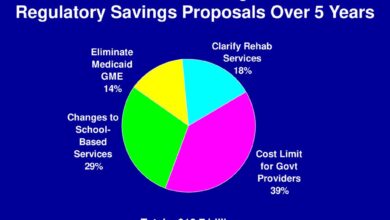
Appellate Court Pauses Ruling Blocking ACA Preventive Care Mandate
Appellate Court Pauses Ruling Blocking ACA Preventive Care Mandate: Whoa, hold up! The legal battle over the Affordable Care Act’s (ACA) preventive care mandate just got a whole lot more interesting. A recent appellate court decision has temporarily paused a lower court ruling that blocked the mandate, leaving millions wondering what this means for their access to vital preventative healthcare services.
This pause throws a wrench into the works, creating uncertainty for both individuals and insurance providers alike. Let’s dive into the details and explore the potential implications of this surprising development.
This unexpected pause creates a fascinating legal and political chess match. The arguments for and against the mandate are deeply intertwined with broader debates about healthcare access, affordability, and the very role of government in public health. We’ll unpack the core arguments, examining the potential consequences of both upholding and striking down the mandate, and exploring how this could reshape future healthcare legislation.
The Appellate Court Decision

Source: medscape.com
The recent appellate court decision to pause enforcement of a lower court ruling blocking the Affordable Care Act’s (ACA) preventive care mandate has sent ripples through the healthcare industry and sparked considerable debate. This temporary halt allows for a more thorough review of the complex legal arguments involved, potentially impacting millions of Americans’ access to essential preventive services.The appellate court’s rationale for pausing the ruling centers on the potential for significant disruption to healthcare access if the lower court’s decision were to stand immediately.
The court acknowledged the serious concerns raised by the plaintiffs regarding religious objections to certain preventive services, but weighed those concerns against the potential harm to public health caused by limiting access to these services. This balancing act is a key aspect of the court’s decision, highlighting the inherent tension between individual religious freedom and the broader public interest in maintaining preventative healthcare access.
Arguments Presented in the Appeal
The plaintiffs, primarily religious employers, argued that the ACA’s preventive care mandate violates their religious freedom by requiring them to provide coverage for services they morally object to, such as contraception. They cited the Religious Freedom Restoration Act (RFRA) as a basis for their claim, asserting that the mandate substantially burdens their religious exercise without a compelling governmental interest.
Conversely, the government argued that the mandate serves a compelling interest in promoting public health by increasing access to preventive care, leading to better health outcomes and reduced healthcare costs in the long run. They emphasized the significant public health benefits of widespread access to preventive services, arguing that these benefits outweigh the religious objections raised by the plaintiffs.
So, the appellate court’s decision to pause the ruling against the ACA’s preventive care mandate is huge news for healthcare access. It makes you wonder about healthcare spending priorities, especially considering that Kaiser Permanente nixes 500m Seattle bed tower capital spending , a move that could impact patient access in the long run. Ultimately, both these events highlight the ongoing complexities and challenges within our healthcare system.
The government also pointed to the accommodations already in place to address religious concerns, arguing that these accommodations sufficiently protect religious freedom without compromising the mandate’s effectiveness.
Timeline of Events
The initial lawsuit challenging the ACA’s preventive care mandate was filed several years ago. A lower court initially ruled in favor of the plaintiffs, finding that the mandate violated their religious freedom. The government then appealed the decision to the appellate court, leading to the current pause in enforcement. This pause is intended to provide the appellate court with sufficient time to fully consider the complex legal issues involved before issuing a final ruling.
The timeline is marked by several legal briefs filed by both sides, detailing their arguments and supporting evidence. This process, though lengthy, is essential to ensure a fair and thorough review of the case.
Comparison to Similar Instances
The appellate court’s decision to pause enforcement is not unprecedented. Similar instances of appellate court intervention in healthcare mandates have occurred in the past, often involving complex legal questions concerning religious freedom, public health, and the balance between individual rights and the common good. For example, previous challenges to vaccine mandates have involved similar legal arguments and considerations of balancing individual rights with public health concerns.
These cases, while not identical, offer valuable precedents and insights into how appellate courts have addressed comparable issues. The present case’s unique aspects, however, involve the specific services covered under the ACA’s preventive care mandate and the specific religious objections raised by the plaintiffs. The court’s ultimate decision will likely influence future litigation involving similar conflicts between religious freedom and healthcare mandates.
Impact on the Affordable Care Act (ACA)

Source: retiredamericans.org
The appellate court’s decision to pause the preventive care mandate within the Affordable Care Act (ACA) has significant ramifications, potentially unraveling a key component designed to improve public health and reduce healthcare costs in the long run. The uncertainty created by this pause introduces a complex web of consequences for individuals, insurance providers, and the overall healthcare system.The pause on the preventive care mandate could severely restrict access to crucial preventative services for millions of Americans.
This includes screenings for cancer, diabetes, and heart disease, as well as vaccinations and other vital health measures. The lack of access to these services could lead to a rise in preventable illnesses, delayed diagnoses, and ultimately, higher healthcare costs down the line. The ripple effects could be particularly damaging to vulnerable populations who rely heavily on these preventative services.
Consequences of Reduced Access to Preventive Care
Reduced access to preventive services directly translates to poorer health outcomes. Delayed diagnoses of serious conditions, such as cancer, often lead to more aggressive and expensive treatments later. For example, a delay in colon cancer screening could mean a later diagnosis, requiring more extensive surgery and chemotherapy, resulting in higher medical bills and a lower chance of survival.
Similarly, the lack of routine vaccinations could lead to outbreaks of preventable diseases, impacting public health and straining healthcare resources. This situation also increases the likelihood of chronic disease development, adding to long-term healthcare burdens for both individuals and the system.
Financial Implications for Individuals and Insurance Providers
The financial impact of this pause is multifaceted. Individuals may face higher out-of-pocket costs for preventative services if they are no longer covered under their insurance plans. This could particularly burden low-income individuals and families, forcing them to forgo essential care due to cost constraints. Insurance providers, on the other hand, might initially see a short-term reduction in claims related to preventive care.
However, this could be followed by a surge in more expensive treatments for advanced conditions resulting from delayed or absent preventative measures. The long-term financial consequences for insurers could be substantial, potentially leading to increased premiums for everyone.
Potential Legal Challenges Arising from the Decision
The appellate court’s decision is likely to face legal challenges. Opponents may argue that the pause violates the ACA’s core tenets, undermining the law’s intended purpose of improving population health and affordability. The legal battles could center on interpretations of the ACA’s language, the authority of the courts to interfere with established healthcare mandates, and the overall impact on public health.
The outcome of these challenges will significantly influence the future of preventative care coverage under the ACA.
Impact on Specific Populations and Healthcare Sectors
The pause could disproportionately affect vulnerable populations, such as low-income individuals, the elderly, and those with chronic health conditions. These groups rely heavily on preventative services to manage their health and avoid costly complications. Furthermore, healthcare providers offering preventive services may experience financial difficulties if the demand for their services decreases due to reduced insurance coverage. This could lead to reduced access to these services, especially in underserved communities.
For example, community health clinics that rely on preventative care revenue to sustain their operations could face significant financial strain, potentially leading to service reductions or closures.
The Preventive Care Mandate Itself
The Affordable Care Act’s (ACA) preventive care mandate is a crucial component of the law, aiming to improve public health by ensuring access to essential preventive services. This mandate requires most insurance plans to cover a broad range of preventive services without cost-sharing, meaning no deductibles, copayments, or coinsurance. This seemingly simple provision has had significant impacts on healthcare access and costs, and its legal challenges highlight its importance in the ongoing debate about healthcare reform.The reasoning behind the mandate’s inclusion is multifaceted.
Firstly, it recognizes that preventive care is far more cost-effective than treating illnesses after they develop. Early detection and intervention can prevent serious conditions from arising, reducing the need for expensive treatments later on. Secondly, the mandate addresses health disparities, ensuring that individuals with limited financial resources can access crucial preventive services. Finally, by encouraging the use of preventive services, the mandate aims to improve the overall health and well-being of the population, leading to a healthier and more productive workforce.
Preventive Services Covered Under the Mandate
The ACA’s preventive services mandate covers a wide range of services recommended by the U.S. Preventive Services Task Force (USPSTF) and other authoritative bodies. These include screenings for various cancers (breast, cervical, colorectal), vaccinations (influenza, pneumonia, etc.), and well-woman visits. Beyond screenings and vaccinations, the mandate also covers services like blood pressure and cholesterol checks, diabetes management, and counseling on smoking cessation and weight management.
The specific services covered are regularly updated based on the latest medical evidence and recommendations from expert panels. The breadth of coverage aims to address a variety of health concerns across different life stages.
Rationale for Inclusion of Specific Services
The inclusion of specific preventive services is based on rigorous scientific evidence demonstrating their effectiveness in preventing or detecting diseases early. For instance, the inclusion of mammograms for breast cancer screening stems from extensive research showing that early detection through mammography significantly improves survival rates. Similarly, the inclusion of colorectal cancer screenings reflects the effectiveness of colonoscopies and other screening methods in detecting and removing precancerous polyps.
The services are chosen based on their demonstrated impact on public health outcomes and cost-effectiveness.
Comparison with Other Countries’ Mandates
Many other developed countries have implemented similar preventive care mandates or initiatives, though the specifics vary. For example, the United Kingdom’s National Health Service (NHS) provides comprehensive preventive care as part of its universal healthcare system. Canada’s publicly funded healthcare system also emphasizes preventive services, though access and coverage may vary across provinces. While the specifics of these mandates differ, the underlying principle – that preventive care is a cost-effective and essential component of a healthy population – is shared globally.
These international examples offer valuable insights into the potential benefits and challenges associated with such policies.
Cost and Benefits of the Mandate, Appellate court pauses ruling blocking aca preventive care mandate
| Aspect | Costs | Benefits | Impact |
|---|---|---|---|
| Initial Implementation | Increased upfront costs for insurers to cover services | Improved public health outcomes, reduced long-term healthcare costs | Potentially higher premiums initially, offset by long-term savings |
| Long-Term Effects | Ongoing costs for providing services | Reduced hospitalizations, fewer chronic disease cases, increased productivity | Significant cost savings over time, healthier population |
| Administrative Burden | Costs associated with tracking and managing preventive services | Improved healthcare efficiency, better coordination of care | Potentially higher administrative costs, but improved overall efficiency |
| Public Health Impact | Investment in public health infrastructure | Reduced mortality rates, improved quality of life | Improved population health and reduced burden on healthcare system |
Arguments for and Against the Mandate

Source: scene7.com
The Affordable Care Act’s preventive care mandate, requiring certain preventive services to be covered without cost-sharing, has sparked significant debate. Understanding the arguments on both sides is crucial to evaluating its impact on healthcare access and affordability. This section will Artikel the key arguments for and against the mandate, highlighting their connections to broader healthcare policy discussions.
The arguments in favor of the mandate generally center on improving public health, promoting preventative care, and ensuring equitable access to necessary services. Conversely, arguments against the mandate often focus on religious freedom concerns, economic burdens on employers and insurers, and potential government overreach.
Arguments in Favor of the Mandate
Proponents of the preventive care mandate emphasize its positive impact on public health and healthcare cost savings in the long run. The following points illustrate the core of their argument:
- Improved Public Health Outcomes: Mandating preventative services leads to earlier diagnosis and treatment of diseases, ultimately improving overall population health and reducing the burden of chronic illnesses.
- Cost Savings Through Prevention: Preventative care is significantly cheaper than treating advanced diseases. By catching problems early, the mandate aims to reduce healthcare costs in the long term, potentially offsetting the initial expenses.
- Health Equity: Ensuring access to preventive services without cost-sharing reduces disparities in healthcare access, particularly for low-income individuals and those with limited insurance coverage.
- Reduced Healthcare Utilization: Preventative measures can reduce the need for more expensive and intensive medical interventions later on, lowering the overall demand on healthcare resources.
- Increased Life Expectancy and Quality of Life: By improving health outcomes and preventing serious illnesses, the mandate contributes to increased life expectancy and a better quality of life for individuals.
Arguments Against the Mandate
Opponents of the mandate raise concerns about religious freedom, economic impacts, and the role of government in healthcare decisions. Their arguments include:
- Religious Freedom Concerns: Some religious employers object to providing certain preventive services, such as contraception, based on their sincerely held religious beliefs. They argue the mandate infringes upon their religious freedom.
- Economic Burdens on Employers and Insurers: The mandate can impose financial burdens on employers and insurers who are required to cover the cost of preventive services without cost-sharing. This could lead to increased insurance premiums or reduced benefits in other areas.
- Government Overreach: Critics argue the mandate represents excessive government intervention in healthcare decisions, potentially limiting individual choice and autonomy in healthcare planning.
- Lack of Cost-Effectiveness for All Services: Some argue that not all preventive services included in the mandate are equally cost-effective, questioning the overall value of the mandate’s broad scope.
- Potential for Moral and Ethical Conflicts: The inclusion of certain services, such as contraception, raises ethical and moral concerns for some individuals and organizations.
Summary of Arguments
The following table summarizes the key arguments for and against the preventive care mandate:
| Argument | For the Mandate | Against the Mandate |
|---|---|---|
| Public Health | Improved public health outcomes, reduced chronic disease burden | N/A |
| Cost-Effectiveness | Long-term cost savings through prevention | Increased costs for employers and insurers, questionable cost-effectiveness of some services |
| Access and Equity | Increased access to preventive care, reduced health disparities | N/A |
| Religious Freedom | N/A | Infringement on religious freedom for some employers |
| Government Role | N/A | Excessive government intervention, limits individual choice |
These arguments highlight the complex interplay between public health goals, individual liberties, and economic considerations in healthcare policy. The debate over the mandate reflects broader discussions about the appropriate balance between government regulation and individual autonomy in healthcare, and the role of government in ensuring both access and affordability.
Potential Future Outcomes
The appellate court’s decision on the ACA preventive care mandate will have far-reaching consequences for healthcare access and the future of the Affordable Care Act itself. Several scenarios are possible, each with significant implications for individuals, employers, and the healthcare system as a whole. The final ruling will hinge on several key factors, and both sides can employ strategic approaches to strengthen their arguments during further proceedings.The appellate court’s ruling could uphold the mandate, partially uphold it, or strike it down entirely.
Each outcome would trigger different responses from the executive and legislative branches, as well as from private insurers and healthcare providers. Understanding these potential outcomes and the factors influencing them is crucial for navigating the uncertainty ahead.
Potential Rulings and Their Impacts
A ruling upholding the mandate would largely maintain the status quo. Preventive services would continue to be covered without cost-sharing, potentially preserving access to vital care for millions of Americans. However, opponents of the mandate might continue to challenge it through other legal avenues or seek legislative changes. Conversely, a ruling striking down the mandate would significantly alter the landscape of healthcare coverage.
Insurers might reconsider their coverage of preventive services, potentially leading to increased out-of-pocket costs for patients. This could disproportionately affect low-income individuals and those with pre-existing conditions, potentially increasing healthcare disparities. A partial upholding of the mandate, perhaps limiting its scope or application, would create a more complex and uncertain environment, requiring further clarification and adaptation by all stakeholders.
The Supreme Court’s previous involvement in similar ACA challenges, such as the individual mandate case, provides a precedent for the potential level of legal and political contention that might follow this ruling.
Factors Influencing the Appellate Court’s Decision
Several factors will likely weigh heavily on the appellate court’s decision. The court will carefully scrutinize the legal arguments presented by both sides, focusing on the statutory interpretation of the ACA and the relevant administrative regulations. The court’s interpretation of the Religious Freedom Restoration Act (RFRA), a key argument raised by religious objectors, will play a crucial role.
Furthermore, the court will consider the broader implications of its decision, including its impact on public health, access to healthcare, and the overall integrity of the ACA. Precedents set by previous court rulings on similar cases will also influence the decision-making process. For instance, the court may look to previous decisions regarding religious exemptions in the context of healthcare mandates.
The court’s composition and the prevailing legal philosophies of the judges involved will also inevitably shape the outcome.
Strategies for Improving the Case
To improve their case during further proceedings, the government could emphasize the public health benefits of the mandate and the potential negative consequences of its repeal. They could also strengthen their arguments related to statutory interpretation and administrative law. Conversely, opponents of the mandate could focus on refining their religious freedom arguments and presenting additional evidence of the potential burdens imposed by the mandate.
They might also highlight the economic implications of the mandate and the potential for regulatory overreach. Both sides may seek to present amicus briefs from relevant stakeholders, such as healthcare providers, religious organizations, and patient advocacy groups, to bolster their arguments and showcase the broader impact of the decision. The strategic use of expert testimony and economic modeling could also be vital in influencing the court’s assessment of the mandate’s impact.
For example, the government might present data on the improved health outcomes associated with increased access to preventive care, while opponents might highlight the potential costs to employers and insurers.
Public Opinion and Political Implications
The appellate court’s decision to pause enforcement of the ACA’s preventive care mandate has sparked a flurry of reactions, highlighting the deeply divisive nature of healthcare policy in the United States. Public opinion is sharply divided along partisan lines, mirroring the broader political polarization surrounding the Affordable Care Act itself. The implications of this ruling extend far beyond the immediate legal battle, impacting the ongoing political debate and potentially shaping future healthcare legislation.The public’s reaction has been largely predictable, with strong opinions expressed on both sides.
Supporters of the mandate, often aligning with Democratic viewpoints, emphasize the importance of preventive care in maintaining public health and argue that the ruling threatens access to crucial services. Conversely, opponents, frequently associated with Republican viewpoints, raise concerns about religious freedom and government overreach, suggesting the mandate infringes on individual liberties and potentially increases healthcare costs. Social media has become a battleground for these competing narratives, with hashtags like #ProtectPreventiveCare and #ReligiousFreedom trending alongside intense discussions and debates.
Media Framing and Political Discourse
The media’s portrayal of the ruling has been heavily influenced by existing political biases. Conservative outlets often frame the decision as a victory for religious freedom and individual choice, emphasizing the potential burdens placed on religious employers. Liberal media, conversely, highlight the potential negative consequences for public health, focusing on the risk of reduced access to essential preventive services like vaccinations and cancer screenings.
So, the appellate court’s decision to pause the ruling against the ACA’s preventive care mandate is huge news, right? It really throws a wrench into things, especially considering the implications for healthcare policy. This comes at a time when Robert F. Kennedy Jr. is clearing hurdles on his path to becoming HHS Secretary, as reported by this article.
His potential appointment could significantly alter the future of the ACA and this latest court decision adds another layer of complexity to the situation. It’ll be fascinating to see how this all plays out.
Political discourse has followed a similar pattern, with politicians using the ruling to reinforce existing narratives and mobilize their bases. For instance, Democratic politicians have used the pause as a rallying cry to advocate for stronger protections for the ACA, while Republicans have framed it as a necessary step towards limiting government overreach.
Hypothetical Future Impact on Healthcare Legislation
Consider a hypothetical scenario where the appellate court ultimately upholds the challenge to the preventive care mandate. This could embolden conservative lawmakers to push for further restrictions on the ACA, potentially leading to legislative efforts to weaken or repeal key provisions. This could manifest as attempts to defund specific programs, limit the scope of coverage, or introduce greater flexibility for employers regarding mandated benefits.
Conversely, a decision in favor of the mandate could strengthen the ACA’s position and embolden proponents to push for even broader expansions of preventive care coverage, potentially including mental health services or addressing social determinants of health. The outcome of this legal battle will significantly influence the trajectory of healthcare policy discussions for years to come, potentially shaping the future of the ACA and influencing how future healthcare legislation is debated and enacted.
The appellate court’s pause on the ruling blocking the ACA’s preventive care mandate is a huge win for public health, especially considering the vulnerable populations it protects. This highlights the importance of seamless care coordination, something reimagining collaboration in senior care a technology driven approach can significantly improve. Ultimately, ensuring access to vital preventive services, as this court decision helps do, is crucial for improving overall health outcomes, especially for our aging population.
The ongoing debate mirrors similar past conflicts, such as the battles over the individual mandate, illustrating the persistent tension between individual liberty and collective well-being within the context of healthcare policy.
Concluding Remarks
The appellate court’s decision to pause the ruling blocking the ACA’s preventive care mandate is a significant development with far-reaching consequences. While the ultimate outcome remains uncertain, this temporary reprieve highlights the ongoing tension between individual liberties and public health concerns. The coming months will be crucial, as both sides prepare their arguments for the final appeal. The impact on millions of Americans’ access to preventative care hangs in the balance, making this a story to follow closely.
Stay tuned for updates as this legal drama unfolds!
Answers to Common Questions: Appellate Court Pauses Ruling Blocking Aca Preventive Care Mandate
What specific preventive services are covered under the ACA mandate?
The mandate covers a wide range of services, including vaccinations, screenings for cancer and other diseases, and preventive counseling services. The exact list can be found on the government’s website.
How will this pause affect my insurance coverage?
For now, your coverage should remain unchanged. However, the outcome of the appeal could significantly alter the future of these services being covered without cost-sharing.
What are the potential long-term consequences of this ruling?
A final ruling against the mandate could significantly reduce access to preventive care, potentially leading to increased healthcare costs and worse health outcomes in the long run. Conversely, upholding the mandate could solidify access to important preventive services.
Who are the main players involved in this legal battle?
The case involves various advocacy groups, religious organizations, and individuals who have challenged the mandate, along with the government defending it.


